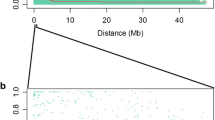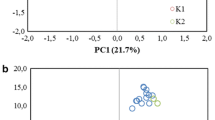Abstract
Key message
Linkage disequilibrium decay in sugar beet is strongly affected by the breeding history, and varies extensively between and along chromosomes, allowing identification of known and unknown signatures of selection.
Abstract
Genetic diversity and linkage disequilibrium (LD) patterns were investigated in 233 elite sugar beet breeding lines and 91 wild beet accessions, using 454 single nucleotide polymorphisms (SNPs) and 418 SNPs, respectively. Principal coordinate analysis suggested the existence of three groups of germplasm, corresponding to the wild beets, the seed parent and the pollen parent breeding pool. LD was investigated in each of these groups, with and without correction for genetic relatedness. Without correction for genetic relatedness, in the pollen as well as the seed parent pool, LD persisted beyond 50 centiMorgan (cM) on four (2, 3, 4 and 5) and three chromosomes (2, 4 and 6), respectively; after correction for genetic relatedness, LD decayed after <6 cM on all chromosomes in both pools. In the wild beet accessions, there was a strong LD decay: on average LD disappeared after 1 cM when LD was calculated with a correction for genetic relatedness. Persistence of LD was not only observed between distant SNPs on the same chromosome, but also between SNPs on different chromosomes. Regions on chromosomes 3 and 4 that harbor disease resistance and monogermy loci showed strong genetic differentiation between the pollen and seed parent pools. Other regions, on chromosomes 8 and 9, for which no a priori information was available with respect to their contribution to the phenotype, still contributed to clustering of lines in the elite breeding material.






Similar content being viewed by others
References
Arnaud JF, Viard F, Delescluse M, Cuguen J (2003) Evidence for gene flow via seed dispersal from crop to wild relatives in Beta vulgaris (Chenopodiaceae): consequences for the release of genetically modified crop species with weedy lineages. Proc R Soc Lond B 270:1565–1571
Arnaud J-F, Fénart S, Godé C et al (2009) Fine-scale geographical structure of genetic diversity in inland wild beet populations. Mol Ecol 18:3201–3215. doi:10.1111/j.1365-294X.2009.04279.x
Atwell S, Huang YS, Vilhjálmsson BJ et al (2010) Genome-wide association study of 107 phenotypes in Arabidopsis thaliana inbred lines. Nature 465:627–631. doi:10.1038/nature08800
Barzen E, Mechelke W (1995) An extended map of the sugar beet genome containing RFLP and RAPD loci. Theor Appl Genet 90:189–193
Barzen E, Mechelke W, Ritter E (1992) RFLP markers for sugar beet breeding: chromosomal linkage maps and location of major genes for rhizomania resistance, monogermy and hypocotyl colour. Plant J 2:601–611
Clark RM, Linton E, Messing J, Doebley JF (2004) Pattern of diversity in the genomic region near the maize domestication gene tb1. Proc Natl Acad Sci USA 101:700–707
Cooke DA, Scott JE (1993) The sugar beet crop. Chapman and Hall, London
Desplanque B, Viard F, Bernard J et al (2000) The linkage disequilibrium between chloroplast DNA and mitochondrial DNA haplotypes in Beta vulgaris ssp. maritima (L.): the usefulness of both genomes for population genetic studies. Mol Ecol 9:141–154
Draycott AP (2006) Sugar beet. Blackwell Publishing Ltd, Oxford
Evanno G, Regnaut S, Goudet J (2005) Detecting the number of clusters of individuals using the software STRUCTURE: a simulation study. Mol Ecol 14:2611–2620. doi:10.1111/j.1365-294X.2005.02553.x
Excoffier L, Lischer HEL (2010) Arlequin suite ver 3.5: a new series of programs to perform population genetics analyses under Linux and Windows. Mol Ecol Res 10:564–567
Falconer DS, Mackay TFC (1996) Introduction to quantitative genetics. Pearson Education Limited, Essex
Fievet V, Touzet P, Arnaud JF, Cuguen J (2007) Spatial analysis of nuclear and cytoplasmic DNA diversity in wild sea beet (Beta vulgaris ssp. maritima) populations: do marine currents shape the genetic structure? Mol Ecol 16:1847–1864
Grimmer MK, Trybush S, Hanley S et al (2007) An anchored linkage map for sugar beet based on AFLP, SNP and RAPD markers and QTL mapping of a new source of resistance to Beet necrotic yellow vein virus. Theor Appl Genet 114:1151–1160. doi:10.1007/s00122-007-0507-3
Hagihara E, Itchoda N, Habu Y (2005) Molecular mapping of a fertility restorer gene for Owen cytoplasmic male sterility in sugar beet. Theor Appl Genet 111:250–255. doi:10.1007/s00122-005-2010-z
Jung C, Pillen K, Frese L (1993) Phylogenetic relationships between cultivated and wild species of the genusBeta revealed by DNA “fingerprinting”. Theor Appl Genet 86:449–457
Kraft T, Fridlund B, Hjerdin A et al (1997) Estimating genetic variation in sugar beets and wild beets using pools of individuals. Genome 40:527–533
Kraft T, Hansen M, Nilsson NO (2000) Linkage disequilibrium and fingerprinting in sugar beet. Theor Appl Genet 101:323–326
Lein JC, Asbach K, Tian Y et al (2007) Resistance gene analogues are clustered on chromosome 3 of sugar beet and cosegregate with QTL for rhizomania resistance. Genome 50:61–71. doi:10.1139/G06-131
Lewellen RT, Skoyen JO, Erichsen AW (1987) Breeding sugar beet for resistance to rhizomania: evaluation of host-plant reactions and selection for and inheritance of resistance. Winter Congress of the IIRB. pp 139-156
Li J, Schulz B, Stich B (2010) Population structure and genetic diversity in elite sugar beet germplasm investigated with SSR markers. Euphytica 175:35–42. doi:10.1007/s10681-010-0161-8
Li J, Luhmann A-K, Weiszleder K, Stich B (2011) Genome-wide distribution of genetic diversity and linkage disequilibrium in elite sugar beet germplasm. BMC Genom 12:484. doi:10.1186/1471-2164-12-484
Liu K, Muse SV (2005) PowerMarker: integrated analysis environment for genetic marker data. Bioinformatics 21(9):2128–2129
Mangin B, Siberchicot A, Nicolas S, Doligez A, This P, Cierco-Ayrolles C (2012) Novel measures of linkage disequilibrium that correct the bias due to population structure and relatedness. Heredity 108:285–291. doi:10.1038/hdy.2011.73
McGrath JM, Derrico CA, Yu Y (1999) Genetic diversity in selected, historical US sugarbeet germplasm and Beta vulgaris ssp. maritima. Theor Appl Genet 98:968–976. doi:10.1007/s001220051157
Murray RS, Larry JS (2007) Theory and problem of statistics, 4th edn. Schaum’s Outlines McGRAW-HILL, New York
Nei M, Li WH (1979) Mathematical model for studying genetic variation in terms of restriction endonucleases. Proc Natl Acad Sci USA 76:5269–5273
Olsen KM, Caicedo AL, Polato N, McClung A, McCouch S, Purugganan MD (2006) Selection under domestication: evidence for a sweep in the rice waxy genomic region. Genetics 173:975–983
Owen FV (1945) Cytoplasmically inherited male-sterility in sugar beets. J Agric Res 71:423–440
Palalsa K, Morgante M, Tingey S, Rafalski A (2004) Long-range patterns of diversity and linkage disequilibrium surrounding the maize Y1 gene are indicative of an asymmetric selective sweep. Proc Natl Acad Sci USA 101:9885–9890
Panella L, Lewellen RT (2007) Broadening the genetic base of sugar beet: introgression from wild relatives. Euphytica 154:383–400. doi:10.1007/s10681-006-9209-1
Patterson N, Price AL, Reich D (2006) Population structure and eigenanalysis. PLOS Genet 2:e190. doi:10.1371/journal.pgen.0020190
Pillen K, Sleinrucken G, Herrmann RG, Jung C (1993) An extended linkage map of sugar beet (Beta vulgaris L.) including nine putative lethal genes and the restorer gene X. Plant Breeding 111:265–272
Pritchard JK, Stephens M, Donnelly P (2000) Inference of population structure using multilocus genotype data. Genetics 155:945–959
Scholten OE, De Bock TS, Klein-Lankhorst RM, Lange W (1999) Inheritance of resistance to beet necrotic yellow vein virus in Beta vulgaris conferred by a second gene for resistance. Theor Appl Genet 99:740–746. doi:10.1007/s001220051292
Schondelmaier J, Jung C (1997) Chromosomal assignment of the nine linkage groups of sugar beet (Beta vulgaris L.) using primary trisomics. Theor Appl Genet 95:590–596. doi:10.1007/s001220050600
Shull GH (1908) The composition of a field of maize. Rep Am Breeders Assoc 4:296–301
Smulders MJ, Esselink GD, Everaert I et al (2010) Characterisation of sugar beet (Beta vulgaris L. ssp. vulgaris) varieties using microsatellite markers. BMC Genet 11:41–52
Stich B, Melchinger AE, Heckenberger M et al (2008a) Association mapping in multiple segregating populations of sugar beet (Beta vulgaris L.). Theor Appl Genet 117:1167–1179. doi:10.1007/s00122-008-0854-8
Stich B, Piepho H-P, Schulz B, Melchinger AE (2008b) Multi-trait association mapping in sugar beet (Beta vulgaris L.). Theor Appl Genet 117:947–954. doi:10.1007/s00122-008-0834-z
VSN International (2011) Genstat for Windows 14th Edition
Weir BS, Cockerham CC (1984) Estimating F-statistics for the analysis of population structure. Evol 38:1358–1370
Würschum T, Maurer HP, Kraft T et al (2011a) Genome-wide association mapping of agronomic traits in sugar beet. Theor Appl Genet 123:1121–1131. doi:10.1007/s00122-011-1653-1
Würschum T, Maurer HP, Schulz B et al (2011b) Genome-wide association mapping reveals epistasis and genetic interaction networks in sugar beet. Theor Appl Genet 123:109–118. doi:10.1007/s00122-011-1570-3
Yan J, Shah T, Warburton ML, Buckler ES, McMullen MD et al (2009) Genetic characterization and linkage disequilibrium estimation of a global maize collection using SNP markers. PLoS ONE 4(12):e8451. doi:10.1371/journal.pone.0008451
Zhao K, Aranzana MJ, Kim S et al (2007) An Arabidopsis example of association mapping in structured samples. PLoS Genet 3:e4. doi:10.1371/journal.pgen.0030004
Author information
Authors and Affiliations
Corresponding author
Additional information
Communicated by J. Yan.
Electronic supplementary material
Below is the link to the electronic supplementary material.
Rights and permissions
About this article
Cite this article
Adetunji, I., Willems, G., Tschoep, H. et al. Genetic diversity and linkage disequilibrium analysis in elite sugar beet breeding lines and wild beet accessions. Theor Appl Genet 127, 559–571 (2014). https://doi.org/10.1007/s00122-013-2239-x
Received:
Accepted:
Published:
Issue Date:
DOI: https://doi.org/10.1007/s00122-013-2239-x




